牛津译林版8A Unit8英语期末复习专题(英语教案)
牛津译林英语单元复习课件8A-Unit8
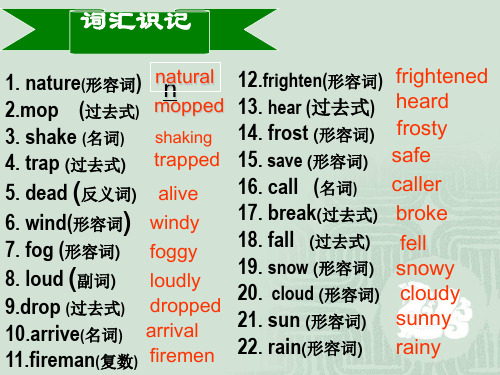
6.Bad weather sometimes __c_a_u_s_e__s__ ___n_a_t_u_r_a_l_ _d__is_a__s_te__rs____.(导致自然灾害)
7.Millie asked me to go to her house because I __fo__rg__o_t__ __t_o___ __b_r_in_g___(忘了带) my keys .
8.I __t_o_l_d___ __m__y_s_e_l_f_(告诫自己) I must _s_t_a_y___ __a_li_v_e__.
( 活下去)
9.When the noise __w_a__s__ __o_v_e__r__(结束),we _w__e_r_e__ _t_ra__p_p_e_d___(被困)in a dark place.
1. 人们急匆匆地把石头移开。 People __w__e_re__in__a_g_r_e_a_t _h_u_rr_y_t_o_m__o_v_e_a_w_a_y___the stones. People __h_u_r_ri_e_d_t_o_m__o_v_e_a_w__a_y_ the stones. People moved away the stones __i_n_a__h_u_rr_y___. People moved away the stones _h_u_r_r_ie_d_ly_ .
local people
重点句型
1.I __w__a_s___ _s_l_e_e_p_i_n_g___(睡觉) when it _s_ta__rt_e_d__ ___to___ ___r_a_in______(开始下雨).
2.The Taiwan earthquake killed t_h_o__u_s_a_n__d_s_ __o_f___ _p_e_o_p__le_
牛津英语8A Unit8教案
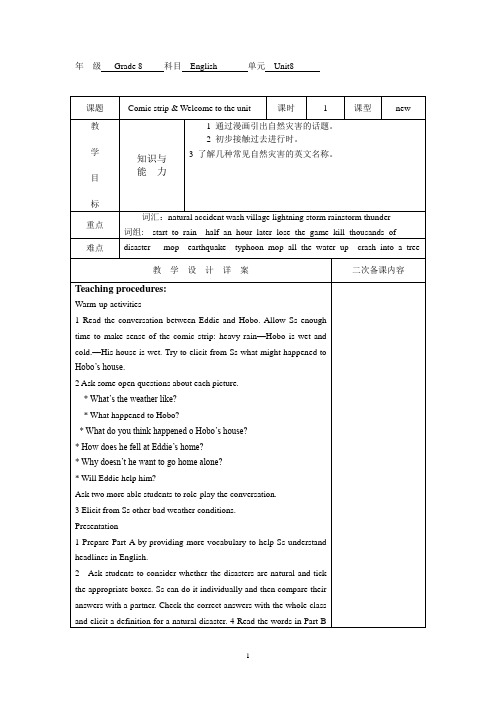
1
课型
new
教
学
目
标
知识与
能力
To read the text again and again and deal with language points
重点
To learn the language points by heart.
难点
To retell the story about Timmy
教学过程
教学内容
备课札记
5. Ask what happened to Timmy then? Tell them to read Para 3 and 4 to find the answer. Present: Timmy was trapped. Explain ‘be trapped’.
6. Ask what Timmy did to save himself after he was trapped? He did five things to help himself. Ask students to read the rest part of the story to find out the answers.
7. Ask students to do part B2 on page96. Help Sandy complete her diary.
8. Students listen to the tape and read after it together.
9. Tell students Timmy put some pictures he draw about the earthquake on his home page. Ask students to complete Part C to put them into the correct order and write the captions in the blanks.
新译林牛津英语八年级上册8AUnit8全单元教案
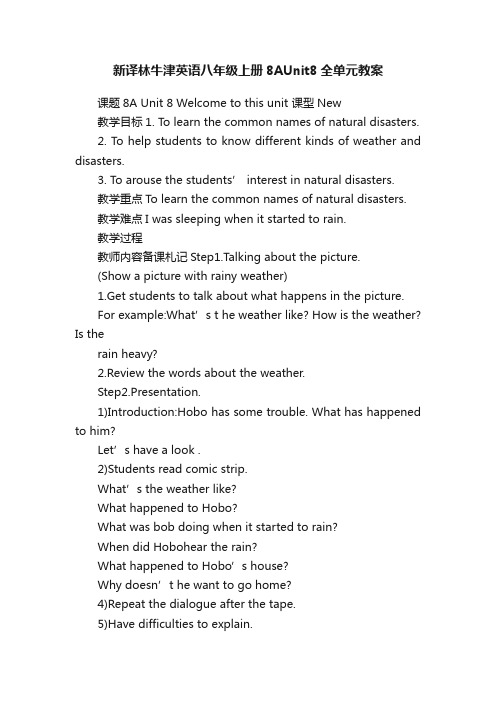
新译林牛津英语八年级上册8AUnit8全单元教案课题8A Unit 8 Welcome to this unit 课型New教学目标1. To learn the common names of natural disasters.2. To help students to know different kinds of weather and disasters.3. To arouse the students’ interest in natural disasters.教学重点To learn the common names of natural disasters.教学难点I was sleeping when it started to rain.教学过程教师内容备课札记Step1.Talking about the picture.(Show a picture with rainy weather)1.Get students to talk about what happens in the picture.For example:What’s t he weather like? How is the weather? Is therain heavy?2.Review the words about the weather.Step2.Presentation.1)Introduction:Hobo has some trouble. What has happened to him?Let’s ha ve a look .2)Students read comic strip.What’s the weather like?What happened to Hobo?What was bob doing when it started to rain?When did Hobohear the rain?What happened to Hobo’s house?Why doesn’t he want to go home?4)Repeat the dialogue after the tape.5)Have difficulties to explain.Be all wet全湿了Mop all the water up用拖把把所有的水拖掉I was sleeping when it started to rain.当开始下雨的时候我正在睡觉。
初中英语译林版备课资料8AUnit 8 Natural disasters讲解分析+教案设计+习题设计+单元检测

Unit 8 Natural disasters单元概述单元教材分析:本单元围绕Natural disasters这个话题展开,让学生谈论了解各种自然灾难以及在各种自然灾难中如何自救,并注意从学生自己生活的实际环境出发,拓展了一些自然现象和自然灾害。
“Comic strip”部分通过Eddie和Hobo的对话情境,激发学生对本单元的学习兴趣,引出天气状况,同时初步导入本单元的重要语法——过去进行时。
“Welcome to the unit”部分通过对比自然灾难与人为事故来了解并掌握几种常见的自然灾难的名称,掌握句式:…if…和Was anyone hurt?等;“Reading”部分通过学习了解台湾地震幸存者Timmy的故事,了解台湾地震的基本情况,培养学生根据关键词和语境猜测大意的能力,学习并掌握大量的词汇、词组和句式,理解使用过去进行时的语境,同时培养学生根据已有的阅读材料抓住故事细节和故事情节发展的能力,引导学生运用正确的阅读技巧,全面提高阅读能力,教育学生在自然灾难中的自我保护。
“Grammar”部分介绍了过去进行时的构成和用法,学会“while”“when”和“as”在过去进行时中的具体运用;“Integrated skills”部分让学生通过听录音,从录音材料中提取信息,补全灾难预防提示表,并以“What should we do first?”让学生学会处理一些日常生活中的突发事故,训练学生的听、说、读、写技能;“Study skills”是英语构词教学中的一种,通过把两个独立的英语单词结合到一起构成另外一个单词,也就是“合成法”。
学生通过学会通过两个单词的意思,猜测出它们构成的新词的意思;“Task”部分通过回顾单元基础知识,学习在写作中陈述事实性信息,让学生根据一些要点完成Sandy 的范文,并根据范文设计出一种自然灾难文章的要点提纲,尝试写出相关文章。
训练学生的写作能力,综合运用英语的能力。
牛津译林版英语八年级上册8AUnit8单元复习课件

4. My dad’s car broke down _b_e_c_a_u_s_e_o_f_t_h_e_c_o_l_d_w__e_a_th_e_r_. 我爸爸的汽车因为寒冷的天气出故障了。
图中女子Nancy是个“手机控”。昨天她在街上因为使用手机发 生了交通事故,请根据图片提示,写一篇90词左右的短文,简要描述 这件事情,并谈谈自己的看法。
注意: 1. 短文已给出的部分不计入总词数。 2. 可适当增加细节,使行文连贯、通顺。 3. 文中不得出现真实姓名和校名。 4. 参考词汇:ambulance救护车 stretcher担架
11. rule(n.)规则(v.)统治,管理
(adj.)昏暗的;深色的,暗色的 →___r_u_le_r__(n.)统治者;管理者
12. burn(n.)烧伤,烫伤,灼伤 (v.)烧伤;烧
→__b__u_r_n_t/_b_u_r_n_e_d___(过去式) →___b_u_r_n_t_/b_u_r_n_e_d___(过去分词)
★__c_a_l_m__d_o_w__n_ 冷静
→___b_e_a_t__(过去式)
(adj.)平静的,沉着的 →__b_e_a_t_e_n_(过去分词)
词汇拓展(针对词语运用) 3. break(v.)损坏;打破[P75]
单一词性
→__b__ro_k_e__(过去式)
1. village(n.)村庄,乡村 →__v_i_ll_a_g_e_r(n.)村民 13次
5. Do you know what to do first if I _b_u_r_n_m__y_s_e_lf_? 你知道如果我烧伤了自己应该先做什么吗?
牛津译林版-英语-八上-8A 8单元复习导学案
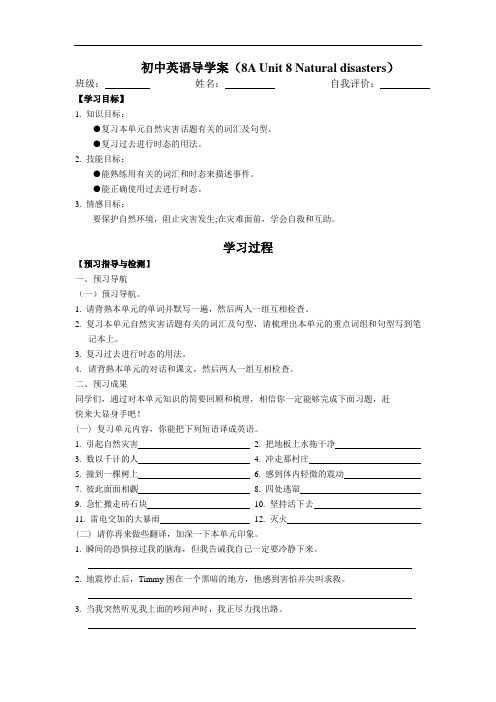
初中英语导学案(8A Unit 8 Natural disasters)班级:姓名:自我评价:【学习目标】1. 知识目标:●复习本单元自然灾害话题有关的词汇及句型。
●复习过去进行时态的用法。
2. 技能目标:●能熟练用有关的词汇和时态来描述事件。
●能正确使用过去进行时态。
3. 情感目标:要保护自然环境,阻止灾害发生;在灾难面前,学会自救和互助。
学习过程【预习指导与检测】一、预习导航(一)预习导航。
1. 请背熟本单元的单词并默写一遍,然后两人一组互相检查。
2. 复习本单元自然灾害话题有关的词汇及句型,请梳理出本单元的重点词组和句型写到笔记本上。
3. 复习过去进行时态的用法。
4.请背熟本单元的对话和课文,然后两人一组互相检查。
二、预习成果同学们,通过对本单元知识的简要回顾和梳理,相信你一定能够完成下面习题,赶快来大显身手吧!(一) 复习单元内容,你能把下列短语译成英语。
1. 引起自然灾害2. 把地板上水拖干净3. 数以千计的人4. 冲走那村庄5. 撞到一棵树上6. 感到体内轻微的震动7. 彼此面面相觑8. 四处逃窜9. 急忙搬走砖石块10. 坚持活下去11. 雷电交加的大暴雨12. 灭火(二)请你再来做些翻译,加深一下本单元印象。
1. 瞬间的恐惧掠过我的脑海,但我告诫我自己一定要冷静下来。
2. 地震停止后,Timmy困在一个黑暗的地方,他感到害怕并尖叫求救。
3. 当我突然听见我上面的吵闹声时,我正尽力找出路。
4. 就在一块块玻璃和砖块落下时,人们在疯狂奔跑。
5. 由于雷电击中,他们的学校着火了。
6. 天气报告说明天气温将下降到-5℃。
(三)同学们, 在完成上面练习以后你对本单元还有什么不够理解的地方,请写下来。
__________________________________________________________________________【课堂导学与互动】活动一:听P94-95的录音并能跟读。
牛津译林版英语八上 期末复习Unit 8

乐吾实验学校八年级英语期末复习——8A Unit 8Important phrases and sentences:1. disaster n. 灾难;不幸,祸患natural disasters 自然灾害2. mop vt. 用拖把擦干净(mopped mopping)up adv 完全地mop up / eat up /clean up /use upmop up 拖干,把......拖干(mop it /them up)eg. Hobo wants Eddie to mop up all the water.3.earthquake n. 地震an earthquake in the earthquake eg. There was an earthquake in Sichuan in 2008.4. 1)thousands of 成千上万的/hundreds of 成百上千的/ millions of 成百万的+名词复数eg. Thousands of people lost their lives in the earthquake.There are thousands of people on the road.2)数词+hundred/thousand/million+名词复数There are three thousand students in our school.5. accident n. 事故,意外的事eg. There was a car accident yesterday.昨天有一场交通事故。
A car accident killed three men three days ago.Three men lost their lives in the car accident three days ago. 在三天前的一场交通事故中三人丧生。
6. coach n. 长途汽车(coaches) get on/off the coachIt took us three hours to go to Nanjing by coach. .7. crash vi. & vt. 猛撞;碰撞crash into 猛撞,碰撞eg. A car crashed into a tree last night. 昨天晚上一辆车猛撞到一棵树上。
牛津译林版八年级英语上册8A Unit 8 Integrated skills 教案
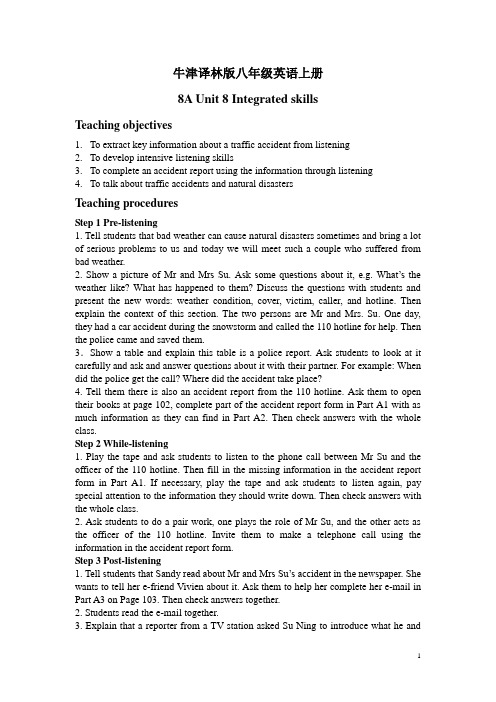
牛津译林版八年级英语上册8A Unit 8 Integrated skillsTeaching objectives1.To extract key information about a traffic accident from listening2.To develop intensive listening skills3.To complete an accident report using the information through listening4.To talk about traffic accidents and natural disastersTeaching proceduresStep 1 Pre-listening1. Tell students that bad weather can cause natural disasters sometimes and bring a lot of serious problems to us and today we will meet such a couple who suffered from bad weather.2. Show a picture of Mr and Mrs Su. Ask some questions about it, e.g. What’s the weather like? What has happened to them? Discuss the questions with students and present the new words: weather condition, cover, victim, caller, and hotline. Then explain the context of this section. The two persons are Mr and Mrs. Su. One day, they had a car accident during the snowstorm and called the 110 hotline for help. Then the police came and saved them.3.Show a table and explain this table is a police report. Ask students to look at it carefully and ask and answer questions about it with their partner. For example: When did the police get the call? Where did the accident take place?4. Tell them there is also an accident report from the 110 hotline. Ask them to open their books at page 102, complete part of the accident report form in Part A1 with as much information as they can find in Part A2. Then check answers with the whole class.Step 2 While-listening1. Play the tape and ask students to listen to the phone call between Mr Su and the officer of the 110 hotline. Then fill in the missing information in the accident report form in Part A1. If necessary, play the tape and ask students to listen again, pay special attention to the information they should write down. Then check answers with the whole class.2. Ask students to do a pair work, one plays the role of Mr Su, and the other acts as the officer of the 110 hotline. Invite them to make a telephone call using the information in the accident report form.Step 3 Post-listening1. Tell students that Sandy read about Mr and Mrs Su’s accident in the newspaper. She wants to tell her e-friend Vivien about it. Ask them to help her complete her e-mail in Part A3 on Page 103. Then check answers together.2. Students read the e-mail together.3. Explain that a reporter from a TV station asked Su Ning to introduce what he andhis wife experienced that day. Tell students: If you are Su Ning, please tell the audien ce about it using the topic ‘My experience during the snowstorm’.Step 4 Speak up1. Say from Mr. Su’s story, we know bad weather can be really dangerous. Sometimes, it can even cause natural disasters. Ask students to listen to a conversation between Sandy and Amy. They are talking about such a natural disaster caused by bad weather.2. Students listen to the tape and answer these questions:No.1 What happened to Vivien’s school last week?No. 2, What caused that disaster?No. 3, Was anybody hurt?3. Students read the conversation in pairs . Then invite some pairs to come forward and role-play it in front of the class.4. Ask students if they have heard about the Taiwan earthquake in 1999. Go through some details about that earthquake with the class.5. Ask students to tell their friend about that disaster. They ca n use Sandy and Amy’s conversation as a model and replace the underlined words with their own ideas.6. Students can talk about any other natural disasters they have experienced or heard about with their partner.。
牛津译林版8AUnit8英语期末复习专题英语教案
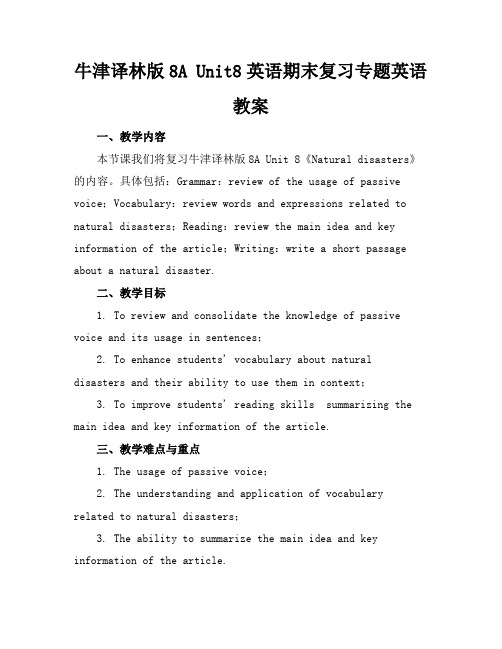
牛津译林版8A Unit8英语期末复习专题英语教案一、教学内容本节课我们将复习牛津译林版8A Unit 8《Natural disasters》的内容。
具体包括:Grammar:review of the usage of passive voice;Vocabulary:review words and expressions related to natural disasters;Reading:review the main idea and key information of the article;Writing:write a short passage about a natural disaster.二、教学目标1. To review and consolidate the knowledge of passive voice and its usage in sentences;2. To enhance students' vocabulary about natural disasters and their ability to use them in context;3. To improve students' reading skills summarizing the main idea and key information of the article.三、教学难点与重点1. The usage of passive voice;2. The understanding and application of vocabulary related to natural disasters;3. The ability to summarize the main idea and key information of the article.四、教具与学具准备1. Blackboard;2. Multimedia projector;3. Handouts with exercises;4. Answer sheets for selfchecking.五、教学过程1. Leadin:Show pictures of different natural disasters and ask students to name them, then elicit the topic of the unit.2. Review of passive voice:Present several sentences about natural disasters and ask students to change them into passive voice. Discuss the usage and rules of passive voice.3. Vocabulary review:Ask students to match the words and expressions related to natural disasters with their definitions. Then have a brainstorming session to see how many words they can recall.4. Reading review:Divide students into groups and ask them to summarize the main idea and key information of the article. Share their answers and discuss as a class.5. Writing practice:Ask students to write a short passage about a natural disaster they have experienced or learned about. Provide them with guiding questions to help structure their writing.6. Oral practice:Pair students up and ask them to discuss the causes and effects of natural disasters. Encourage them to use the vocabulary they have reviewed.六、板书设计1. Passive voice:Rules and examples;2. Vocabulary:List of words and expressions related to natural disasters;3. Main idea and key information of the article.七、作业设计1. Write a short passage about a natural disaster using passive voice;2. Translate the following sentences into English using the vocabulary learned:洪水造成了严重的损失。
2017-2018学年牛津译林版初中英语8A Unit8 Grammar 教案

2017-2018学年牛津译林版初中英语8A Unit8《英语》(八年级上册)Unit 8 Natural disastersGrammarI. Teaching aims and learning objectivesBy the end of the lesson, students should be able to:1. use the past continuous tense to talk about things that were happening at a particular time in the past;2. use conjunctions of time “when, while, as” to talk about things.II. Teaching contents1. New words and phrases: break down, because of2. New structures: I was sleeping when the earthquake started.Outside, people were running in all directions while pieces of glass and brickswere falling down.Hours later, as I was trying to find my way out, I suddenly heard some noiseabove me.III. Focus of the lesson and predicted area of difficultyIntroduce the structure of the past continuous tense.Tell the differences among “when, while, as”.IV. Teaching proceduresA Past continuous tenseStep 1 Lead-in1. Show some pictures of the Taiwan Earthquake, and ask three questions:What was Timmy doing when the earthquake started?What were people doing while pieces of glass and bricks were falling down?What did Timmy suddenly hear as he was trying to find his way out?2. Watch a video and then answer a questionWhat were people doing when the earthquake happened?【设计意图】有目的、有意义地导入,既复习了阅读部分学习的内容,同时也引导学生思考过去进行时态。
牛津译林版8aunit8task教学设计
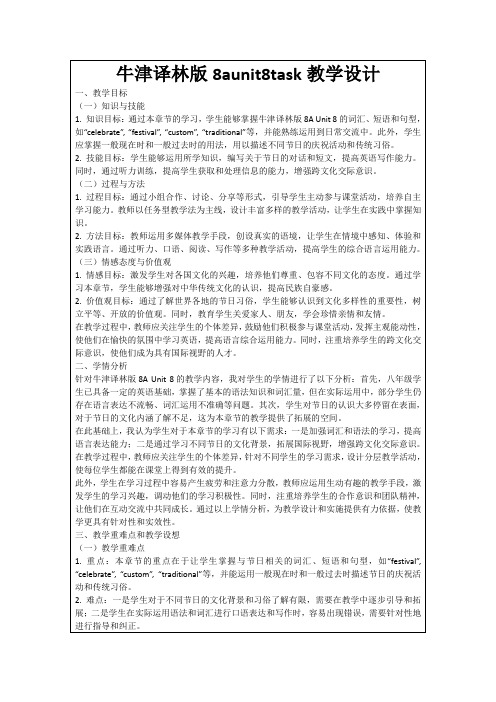
针对牛津译林版8A Unit 8的教学内容,我对学生的学情进行了以下分析:首先,八年级学生已具备一定的英语基础,掌握了基本的语法知识和词汇量,但在实际运用中,部分学生仍存在语言表达不流畅、词汇运用不准确等问题。其次,学生对节日的认识大多停留在表面,对于节日的文化内涵了解不足,这为本章节的教学提供了拓展的空间。
3.阅读作业:阅读教材中关于世界不同节日的文章,完成课后阅读理解练习题,进一步了解各国节日的文化背景。
设计意图:提高学生的阅读理解能力,拓宽国际视野,增强跨文化交际意识。
4.词汇积累:收集与节日相关的词汇和短语,并制作成词汇卡片。卡片内容包括词汇、词性、中文意思和例句。
设计意图:帮助学生积累词汇量,提高词汇运用能力。
2.设计意图:培养学生的合作意识和口语表达能力,了解不同节日的文化差异。
3.教学步骤:
a.教师提出讨论问题,学生小组讨论;
b.各小组汇报讨论成果,分享节日习俗和文化差异;
c.教师点评并总结各小组的发言;
d.邀请学生代表进行角色扮演,模拟节日庆祝活动。
(四)课堂练习
1.教学活动:设计一系列与节日相关的练习题,包括填空、选择、改错和写作等。
2.技能目标:学生能够运用所学知识,编写关于节日的对话和短文,提高英语写作能力。同时,通过听力训练,提高学生获取和处理信息的能力,增强跨文化交际意识。
(二)过程与方法
1.过程目标:通过小组合作、讨论、分享等形式,引导学生主动参与课堂活动,培养自主学习能力。教师以任务型教学法为主线,设计丰富多样的教学活动,让学生在实践中掌握知识。
三、教学重难点和教学设想
(一)教学重难点
1.重点:本章节的重点在于让学生掌握与节日相关的词汇、短语和句型,如“festival”, “celebrate”, “custom”, “traditional”等,并能运用一般现在时和一般过去时描述节日的庆祝活动和传统习俗。
2024年牛津译林版8A Unit8英语期末复习专题英语教案

2024年牛津译林版8AUnit8英语期末复习专题英语教案一、教学目标1.巩固和运用Unit8所学的词汇、句型和语法知识。
2.提高学生的英语听说读写能力,尤其是阅读理解和写作能力。
3.培养学生的团队合作精神和创新能力。
二、教学内容1.词汇:复习Unit8的词汇,包括名词、动词、形容词、副词等。
2.句型:复习Unit8的主要句型,如一般过去时、过去进行时等。
3.语法:复习Unit8的语法知识,如过去时态的构成和用法。
4.阅读理解:通过阅读练习,提高学生的阅读理解能力。
5.写作:训练学生运用所学知识进行写作。
三、教学重点与难点1.重点:复习Unit8的词汇、句型和语法知识,提高学生的阅读理解能力和写作能力。
2.难点:过去时态的正确运用,阅读理解的技巧。
四、教学过程1.导入教师通过提问方式引导学生回顾Unit8所学内容,如:“Canyoutellmesomethingaboutthepasttense?Whatarethekeyvocab ularyinUnit8?”2.词汇复习教师展示Unit8的词汇表,让学生快速回忆并说出每个单词的中文意思。
教师挑选一些重点词汇,让学生用这些词汇造句。
3.句型复习教师通过举例,让学生复习Unit8的主要句型,如:“Iwasdoingmyhomeworkwhenthephonerang.Hewenttothemoviesyest erday.”教师让学生模仿例句,自己编写一些句子。
4.语法复习教师通过讲解和练习,帮助学生复习过去时态的构成和用法。
教师让学生做一些填空题,巩固过去时态的语法知识。
5.阅读理解教师展示一篇与Unit8主题相关的阅读材料,让学生阅读并回答问题。
教师引导学生分析文章结构,提取关键信息,提高阅读理解能力。
6.写作训练教师给出一个写作题目,如:“Describeamemorableeventinyourlifeusingthepasttense.”教师引导学生梳理思路,列出要点,然后让学生开始写作。
牛津译林版八年级英语上册8 A Unit 8 复习教学案
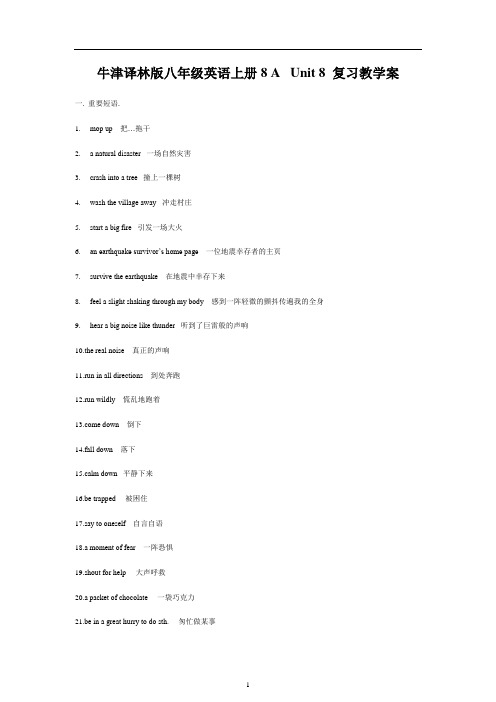
牛津译林版八年级英语上册8 A Unit 8 复习教学案一. 重要短语.1. mop up 把…拖干2. a natural disaster 一场自然灾害3. crash into a tree 撞上一棵树4. wash the village away 冲走村庄5. start a big fire 引发一场大火6. an earthquake survivor’s home page一位地震幸存者的主页7. survive the earthquake 在地震中幸存下来8. feel a slight shaking through my body 感到一阵轻微的颤抖传遍我的全身9. hear a big noise like thunder 听到了巨雷般的声响10.the real noise 真正的声响11.run in all directions 到处奔跑12.run wildly 慌乱地跑着e down 倒下14.fall down 落下15.calm down 平静下来16.be trapped 被困住17.say to oneself 自言自语18.a moment of fear 一阵恐惧19.shout for help 大声呼救20.a packet of chocolate 一袋巧克力21.be in a great hurry to do sth. 匆忙做某事22.move away the bricks and stones 搬走砖块和石头23.the loud noise following lightning 闪电后的巨大声响24.drop a little 有点下降drop to -5℃降到-5℃25.make excuses 编理由26.lose our umbrella in the wind 在风中丢了伞27.get all wet 浑身湿透28.run down the stairs 跑下楼梯29.turn off the lights 关灯30.walk out of the classroom one by one 一个接一个地走出教室31.time of arrival 到达的时间32.conditions of victims 遇难者的情况33.catch fire 着火34.share an umbrella with Millie 和米莉共用一把伞35.remove the snow 扫雪36.typhoon signal number 台风数字信号37.snowstorm warning 暴风雪警报38.roll up trousers 卷起裤子二. 重要句子.1. The Taiwan earthquake killed thousands of people 有数千人在台湾地震中丧生。
2017-2018学年牛津译林版初中英语8A Unit8 speak up and study skills教案

3.Go and see the doctor.
【当堂检测】
We should follow traffic _____ (规则).
2. There is a _______ (铁路) station in Yancheng.
He is making p_______ at home.
When you get hurt, what should you do first? Millie and Daniel are talking about first aid. Listen to their conversation and answer the following questions.
4. What should we do when we b___ ourselves.
5. Does he usually do h________ at home?
学生活动指导:
1.自由读,独立思考。
2.讨论,得出答案。
学生活动指导:
1.小组合作,做对话。
2.组内展示。
3.正确的可为小组加2分。
第三次备课(反思)
得:通过本节课的学习,学生能掌握一些急救方式,并能做新的对话,一些后进生在小组合作中也得到了提升。
失:一些学生对话做的不好,所犯错误较多。
改:课后老师多关注后进生。
2017-2018学年牛津译林版初中英语8A Unit8
电子备课格式(最新)
课题
8A unit8 speak up and study skills
主备
赵玉宇
主核
王颖
使用者
武传虎
牛津译林英语8AUnit8单元复习课件
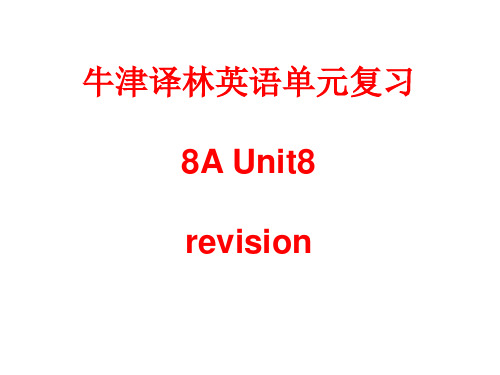
4.mind n. [C]头脑;思想 vt. 介意
因为 大雨,所以他来不了了。
because He can’t come __________ it is raining heavily. because of the heavy rain. He can’t come __________
他没来上学是因为他生病了。
He isn’t at school __________ because of his illness.
Phrases
1.把…拖干净(代词放中间)mop…up 把它/它们拖干净 mop it /them up 把水拖干 mop the water uቤተ መጻሕፍቲ ባይዱ= mop up the water
2.将…冲走(代词放中间)wash…away 将它/它们冲走 wash it /them away 冲走村庄 wash away the village =wash the village away
你有聪明的大脑。 mind You have a good ______.
您不介意我再问您一个问题吧? mind Do you ______if I ask you one more thing?
5. alive adj. 活着的 她一定还活着。
live vi. 活着,生活,居住
通常不放在名词前作定语 (可作表语或后置定语):
3. catch fire 着火
be on fire 着火 (强调状态)
牛津译林版8AUnit8英语期末复习专题英语精品教案

牛津译林版8A Unit8英语期末复习专题英语精品教案一、教学内容本节课我们将复习牛津译林版8A Unit 8《Fashion》这一章节内容。
具体包括:Reading部分时尚品牌介绍,Grammar部分过去进行时,Task部分时装设计,以及Supplementary reading部分时尚潮流。
二、教学目标1. 让学生掌握与时尚相关词汇和表达方式。
2. 巩固过去进行时用法,并能在实际情境中灵活运用。
3. 培养学生审美观和创造力,通过设计时装展示出来。
三、教学难点与重点1. 教学难点:过去进行时用法,时尚词汇掌握。
2. 教学重点:运用过去进行时描述正在进行事情,以及时尚相关词汇运用。
四、教具与学具准备1. 教具:PPT、黑板、时装设计素材。
2. 学具:课本、练习本、彩色笔。
五、教学过程1. 实践情景引入(5分钟)利用PPT展示时尚品牌和时装周图片,引导学生谈论自己对时尚理解和看法。
2. 例题讲解(10分钟)以Reading部分时尚品牌为例,讲解过去进行时用法,并让学生模仿造句。
3. 随堂练习(10分钟)让学生结合Grammar部分练习,运用过去进行时描述图片中场景。
4. 课堂互动(15分钟)分组讨论Task部分时装设计,每组选择一个主题,用英文描述设计理念和过程。
5. 展示与评价(10分钟)各组展示自己时装设计,其他同学用英文进行评价。
6. 课堂小结(5分钟)七、作业设计1. 作业题目:以Supplementary reading部分时尚潮流为素材,写一篇关于自己喜欢一种时尚潮流英文短文。
2. 答案:略。
八、课后反思及拓展延伸1. 课后反思:通过本节课学习,学生对过去进行时掌握程度如何?对时尚相关词汇运用是否熟练?2. 拓展延伸:鼓励学生在课后关注时尚资讯,解不同时尚潮流英文表达,为下一节课分享做好准备。
重点和难点解析在教学过程中,有几个细节是我需要重点关注。
是教学内容选择与组织,是教学难点和重点把握,接着是教学过程合理安排,以及作业设计针对性和课后反思深度。
牛津译林版8AUnit8教案

Unit 8 Natural disastersComic strip & welcome to the unitTeaching aims1.to introduce the topic “Natural disasters”.2.To identify vocabulary related to the topic.Teaching content1.learn some new words: natural, accident, wash, village, lightening, storm, rainstorm, thunder, etc.2.Learn some phrases: mop up , lose the final, wash away, catch fire, start fire.3.Sentences:I was sleeping when it started to rain.Didn’t you hear the rain?Who’s going to mop up the water if I go home without you?Was anyone hurt?Difficulties and key points1.to grasp the new words of natural disasters.2.To distinguish the natural disasters from accidents.Teaching aidssome pictures , a tape-recorder &multimediaTeaching proceduresStep1 :Lead-inBefore this lesson, the teacher can collect some pictures about some natural disasters.In class, the teacher show these pictures to the students, and ask them, “ What can you see in the picture?”, “What happened to these things/people?”Step 2: Presentation1.Revise the change between adjectives and adverbs.2.Ask students: What is the weather like today? What ‘re the disasters? What are natural disasters?Step 3: Practice1.Look at the pictures of the dialogue. Guess what’s wrong with Hobo?2.Play the recording, listen and answer the following questions:⑴What’s wrong with Hobo?⑵Why does Hobo ask Eddie to go home with him?3.Ask several pairs to practise the dialogue.4.Notes:(1)Didn’t you ...?(2)... if ...(3)一段时间+ laterAfter + 一段时间Step 4: Learning1.Guessing games:The teacher describes some kinds of disasters and get students to guess what they are .2.Practice reading the new words and phrases.3.Get students to complete Part A.4.Notes:(1)Accident 可数名词;an accident 不可数名词:by accident(2)Thousands of (不确定数) two thousand (确定数)Step 5: Free talk1.Get students to listen to the record of the conversation and practice reading it.2.Get students to talk about some natural disasters in their life freely.Step Homework1.Memorize the words of natural disasters.2.Talk about more disasters.Unit 8 Natural disastersReadingTeaching aims1.To infer meaning from keywords and context.2.To grasp the language points in the context.3.To develop the students’ ability of reading and using English.4.To make students learn more about the damage caused by the earthquake.Teaching contentWords: shaking , body, fear, scream, shake, direction, glass, brick, calm, moment, mind, since, alive, loudly,etc. Phrases: at first ,in fear, run out of, in all directions, fall down, come down, be trapped, go through, calm down, shout for help, pull through, find one’s way, move away, etc.Sentences:I was sleeping when the earthquake started.... people were running in all directions while pieces of glass and bricks were falling down.... I told myself to calm down since I was still alive.... I did not know if anyone else was near me.... there was just just enough space for me to move.Difficulties and key points1.To grasp the language points in the text.2.To finish the exercises about the reading comprehension.3.To recite the whole text.4.To understand the object clause.Teaching aidsmultimedia, a tape-recorder, some wall chartsTeaching proceduresStep1 :Lead-inMethod 1: Show some pictures about. Wenchuan earthquakes to students, make them remember the situation in 12 th May. Think about the power of earthquake.Method 2: Ask two pairs of students to perform the dialogue of last lesson. Show pictures about earthquake to the students and ask them to say something about the pictures.Step 2: Presentation1.Show some pictures or videos about Wenchuan earthquake.2.We all remember the Wenchuan earthquake, but we know little about the Taiwan earthquake. There was a survivor in the Taiwan earthquake,we want to know what happened to Timmy.Step 3 : Leading1.Listen to the passage, answer the following questions:(1)Where are Timmy?(2)What happened to the people and buildings?(3)Where was Timmy when the shaking stopped?(4)What did Timmy do while he was waiting for help?(5)How was Timmy saved?2.Check out the answers. Then play the recording for the students to listen to.3.Write some keywords on the blackboard, then play the recording again, the students just listen without books and look at the keywords to understand the passage.Step 4: Activities1.Do the exercises in B1 and B2 on page 95.2.Play the recording again, let the students listen and repeat.3.Read the passage, then do exercises in B3 and B4 on page 96.Step 5 : Explanation1.shake v. --- shaking n.2.slight adj. --- slightly adv.3.In all directions4.try one’s best to do sth.5.finally = at last = in the end6.calm v. & adj.7.If 引导的宾语从句8.I did not even know where I was.9.say to oneself10.alive adj. 作后置定语与表语Step 6 : Practice1.Finish the rest of the exercises.2.Read the passage one by one.3.Retell the passage with keywords.Step 7 : Homework1.Recite the whole passage.2.Remember the language points.Unit 8 Natural disastersGrammarTeaching aims1.To understand the basic structures of past continuous tense.2.To master the past continuous tense.3.To use the past continuous tense with “when ”, “as” and “while” correctly. Teaching contentWords: terrible, break, snowball, snowman, hitPhrases: break down, because of , come into, fall over, run towards Sentences:I was sleeping. They were not sleeping. Were you sleeping?I saw you and your parents standing on the side of the road.He was ringing someone to come and help when Millie saw us.As I was trying to find my way out, I suddenly heard some noise above me.While Millie was watching TV. Andy came into the room.Difficulties and key points1.To use the past continuous tense correctly.2.To master the differences between “when” and “while”.Teaching aidsmultimedia,some pictures and cardsTeaching proceduresStep1 :Lead-inMethod 1: T: What are you doing?S: We are having at English class.T: What were you doing at this time yesterday?S: We were having a Geography class.Method 2: T: After learning a passage about earthquakes, are you interested in it? Students in Class 1 Grade 8 are trying to find more about earthquakes. Let’s see what they did yesterday.Step 2: Presentation1.Ask students some questions ,create plots and scenes to use past continuous tense.2.Help students understand that the past continuous tense is used to talk about things that were happening some time in the past .3.Write the basic structure on the blackboard: “was / were (not) + v. -ing”.4.Give examples of changing the sentences into negative sentences, and how to ask and answer questions using the past continuous tense.Step 3 : Activities1.Finish the exercise in Part A. Then check the answers.Notes:(1)look for/ find(2)See sb. Doing sth./do sth.(3)It’s time to do sth./ for sth.2.Ask some students to make sentences with the past continuous tense.Step 4: Presentation1.Ask some questions about the dialogue in Part A. write the answers on the blackboard. Underline the word “when” and “while”.E.g. T: What was Millie doing when the snowstorm came?Millie was walking to the bus stop when the snowstorm came.Show more sentences like this on the blackboard.2.Help students to work out the rule. When we talk about a longer action, we usually use “while”. or “as”.Step 5 : Activities1.Finish the exercises in Part B. then check the answers.2.Make sentences using “when” and “while”.e.g.(1) While my mother was cooking supper, my father was reading newspapers.(2) When I came home, my little dog was sleeping.(3) The students were talking when the teacher came in.(4) My sister was listening to the music while my brother was watching TV.Step 6 : HomeworkUnit 8 Natural disastersIntegrated skillsTeaching aims1.To listen to the recording and make some notes according to different “natural disasters”.2.To complete the dialogue about different disasters according to the recording.3.To talk about dealing with different accidents.Teaching contentWords: danger, situation, burn, follow , safety, should, moreover, pancakes, dangerous,etc.Phrases: away from, cover with, as....as possible, protect ... from... be on fire, take a lift, traffic accident, stay away from, keep one’s hand in cold water, put on etc.Sentences:Look carefully, right and left when you cross the road.Do you know what to do first if I burn myself?Difficulties and key pointsTo get the correct information from the listening materials.Teaching aidscharts, a tape-recorder and multimediaTeaching proceduresStep1 :Lead-inT: Good morning, everyone! Today we’ll do some listening exercises. It’s about “protecting yourself from danger”. what should you do when you are in danger? Firstly, let’s revise some knowledge about “natural disasters”.Step 2: Presentation1.Ask students to look through the exercise in Part A1 before they listen.2.Play the recording for the students to listen and write down the correct telephone numbers.Step 3 : Listening and practicing1.Help students go through the notes in Part A2, tell them what they should do.2.Play the recording for students to listen and complete the notes.3.Check their answers.Step 4:Listen againLet students listen to the tap again and finish Part A3. Then check the answers and explain some language points.Eg: moreover, be on fireIt’s dangerous to use lifts during points.Step 5 : Activities1.Ask : What should you do when you face an accident? Get some students to tell the whole class what they should do.2.Play the tape for the students to listen to .Ask : What is the accident?How should Millie deal with the burn?3.Divide students into groups and practise the dialogue using their own information.4.Encourage some pairs to act out their dialogues in front of the whole classStep 7 : Homework1.Go over the language points in this part.2.Practice more dialogues about “ Protecting yourself from danger”.Unit 8 Natural disastersStudy skillsTeaching aims1.To learn how to form the compound words.2.To divide the compound into two parts correctly.Teaching content1.To master the rules of forming the compound.2.Words: create, pancake, relationship, separate, headachePhrases: put... together, compound words, separate intoSentences: We can put two words together to create new words.Sometimes we can remember words more easily by separating some compound words into two words. Difficulties and key pointsTo learn to form the compounds and divide them into parts correctly.Teaching aidssome cards and multimediaTeaching proceduresStep1 :Lead-inT: Today, we are going to learn a new kind of forming words. Now look at the cards.The teacher puts two cards with words that have been learnt, and ask:Can you know the new words?S: Yes, classroom, classmate, earthquake, etc.Help students summarize the rules of forming the new words.Step 2: Presentation1.Write down these words on the blackboard.2.Get students to read through these words and guess their meanings.Step 3 : Discussion1.Divide the whole class into several groups and discuss the rules of forming new nouns.2.Ask students to think out more compound words.3.Get some students from each group to present their results to the whole class, the teacher help them summarize the rules.4.Get students to write the correct words in the blanks in Part A according to the word-building rules.Step 5 : PracticeGive students some minutes to divide these words into two parts. Then check their work.Step 6 : BrainstormingGive students to think about this kind of word-formation, then tell more words about it.E.g: football, notebook, waiting-room, etc.Step 7 : Homework1.Revise this kind of word formation.Find out more words like these.Unit 8 Natural disastersTaskTeaching aims1.To generate ideas about natural disasters.2.To organize ideas using Sandy’s notes.3.To organize ideas for writing an article about a natural disaster for the school newsletter.Teaching content1.To learn to organize ideas about the article “natural disasters” according to Sandy’s notes.2.To complete Sandy’s article and use the article as a model to write a short article.3.Words: hit ,share, terrible, nearly, sweep, umbrella.Phrases: share with, sweep away, pull through, fall over, look out ofSentences: We could only hear the wind blowing.The snow kept falling around us.I share an umbrella with her while we were walking to the bus stop.Difficulties and key pointsTo writ an article about “natural disasters”.Teaching aidsPictures, a tape-recorder&multimediaTeaching proceduresStep1 :Lead-in1.Show some pictures about different “natural disasters” and let students talk about them in pairs.2.Play a short video about an earthquake and get students to answer some questions.Step 2: Presentation1.T: Good morning /afternoon / evening, everyone! Today we will hear a story about a snowstorm. Do you want to know what has happened? Let’s go and see.2.Ask some students to read the notes one by one on page 102.Step 3 : Leading1.Explain the notes in Part to students.2.Tell students the notes can be divided into three parts; the introduction, the things happened during below the snowstorm and after the snowstorm.3.Let students discuss the form of writing notes.e the words and sentences below the notes on page 102 to talk about different “natural disaster ”Step 4: Activities1.Read through the passage on page103 and help students understand the whole passage.plete the passage using the information in Part A.3.Ask two students to read the passage.Notes:(1)hit → hit(过去式)→ hit(过去分词)(2)share sth. with sb.(3)keep doing sth.(4)fall over(5)look out ofStep 5 : Explanation1.Divide students into several groups to talk about a natural disaster.anize the ideas using the useful expressions in Part A.3.Ask some students to read their notes in front of the whole class.Step 6 : Practice1.Get students to write an article about a natural disaster on their own.2.Show their works to the whole class.Step 7 : Homework1.Revise the language points in this unit.2.Do some exercises of this unit.。
牛津译林版8AUnit8英语期末复习专题英语优质教案

牛津译林版8A Unit8英语期末复习专题英语优质教案一、教学内容本节课我们将复习牛津译林版8A Unit 8《Fashion》这一单元。
具体内容包括:Grammar部分,一般过去时和现在完成时运用;Reading部分,理解并分析课文《Fashion show》中时尚元素;Vocabulary部分,学习并掌握与时尚相关词汇和表达方式。
二、教学目标1. 让学生掌握一般过去时和现在完成时用法,并能在实际语境中灵活运用。
2. 培养学生阅读理解能力,能分析课文中时尚元素。
3. 扩充学生词汇量,掌握与时尚相关词汇和表达方式。
三、教学难点与重点1. 教学难点:一般过去时和现在完成时区别与运用。
2. 教学重点:阅读理解能力培养和时尚相关词汇掌握。
四、教具与学具准备1. 教具:PPT、黑板、粉笔、教学光盘。
2. 学具:课本、练习册、字典、笔记本。
五、教学过程1. 导入:通过播放一段时尚秀视频,引起学生对时尚话题兴趣,进而导入本节课学习内容。
2. 语法讲解:讲解一般过去时和现在完成时区别与运用。
过程细节:通过例句、图表等形式进行讲解,让学生在实际语境中感受两种时态用法。
3. 阅读分析:分析课文《Fashion show》中时尚元素。
过程细节:引导学生从文中提取关键信息,分析时尚元素,并进行课堂讨论。
4. 词汇学习:学习与时尚相关词汇和表达方式。
过程细节:通过PPT展示,让学生跟读、模仿,并进行小组活动,巩固所学词汇。
5. 随堂练习:设计相关语法、阅读和词汇练习,检验学生学习效果。
过程细节:学生独立完成练习,教师对答案进行讲解,并对学生疑问进行解答。
六、板书设计1. 语法部分:板书一般过去时和现在完成时区别与例句。
2. 阅读部分:板书课文中关键信息和时尚元素。
3. 词汇部分:板书与时尚相关词汇和表达方式。
七、作业设计1. 作业题目:(1)用一般过去时和现在完成时各写一段话,描述自己一次购物经历。
(2)根据课文《Fashion show》,列举出你认为最有特色三个时尚元素,并简要说明原因。
牛津译林八年级英语上册Unit 8期末复习案

牛津译林八年级英语上册Unit 8期末复习案Task1:Words1. 默写下列单词.地震长途汽车洪水,水灾村庄,乡村风暴,暴雨摇动,振东害怕,恐惧方向 寂静的 紧张不安的 心脏 由于,既然 活着的 黑暗 日光 安全的 睡着的 铁路 规则 孙女 木板 工作日 头疼 牙疼 乡下,农村 烙饼,薄饼 几乎,将近 清除,清理 在后面Task2: the important phrases and sentences1.Phrases 英汉互译2. The important sentences (ways: read& remember )①我正在睡觉,这时地震开始了。
②一开始,我感到一阵轻微震动。
③我尽力跑出大楼。
④我感到紧张,心跳很快。
⑤片刻的恐惧掠过我的大脑。
⑥我告诉自己镇静下来,因为我还活着。
⑦我看到你和你父母正站在路边上。
⑧由于寒冷的天气,我爸爸的车坏了。
⑨米莉正在看电视的时候,安迪走进了房间。
Task3:Grammar(一) 过去进行时1. 判断方法:一般有过去的具体的点时间,或者一段时间,如:at 10 o’clock last night/ at this time the day before yesterday/ from … to …/ between … and …/ the whole morning …a)where _______ they ________(discuss) it between 3 p.m. and 5 p.m. yesterday?b)He with his classmates __________(not watch) TV at this time yesterday.c)-Did you see a girl in red pass by just now? ―No, sir. I __________(read) a newspaper.(二) when/ while/as1. A. 当两个延续的动作同时发生,两个句子都可用过去进行时来表示,用while连接,如:1.People ________ (run)in all directions while pieces of glass and bricks ________ (fall) down.2. Yesterday afternoon, while Daniel __ _____ (work) on the computer, Millie ______ (stand) beside him.B. 当一个延续的动作正在发生的时候,另外一个瞬间动作发生了,用“when”连接,较长的动词用过去进行时,较短动词用一般过去时,when释为:“就在那时”We ______ (read) a terrible story when suddenly the lights ______ (go) out..C. As的同时进行主要表示动作发生的背景或条件,意思为“随着……”;“一边……,一边”As I (try) to find my way out, I suddenly (hear)some noise above me.八年级英语期末复习课堂检测(04)一、根据句子意思和所给提示,完成下列单词1. There were two air ________ (灾难) last month.2. Children are usually afraid of ________ (打雷声).3. Mother was ________ (拖) the floor when I got home.4. The ________ (地震) in Yunnan in October made many people lose their homes.5. It’s dangerous to travel by ship this week because there will be a ________ (风暴) on the sea.6. They went to the World Park by ________ (长途汽车).7. The snow and ice on the road caused many a________ last week.8. I don’t like living in a noisy city. I hope to live a quiet life in a small v________.9. Try your best to keep the new words in your ________ (头脑).10. The girl was full of ________ (害怕) when she saw the snake.11. Most buildings in this area are made of ________ (砖头) and stones.12. He feels ________ (紧张不安的) when he faces so many people.13. My ________ (心) was in my mouth when I walked into her office.14. The difference between them is so ________ (轻微的) that I can hardly see it.15. We should keep ________ (silence) in the library.16. A good driver usually has a good sense of ________ (direct).17. The film was so boring that I fell ________ (sleep) half way through it.18. I was surprised to see my pet cat was still ________ (live) after the big fire.19. When she knew the story, I saw a slight ________ (shake) through her body.20. All the visitors were ________ (trap) on the top of the mountain because of the sudden snowstorm.21. Her heart ________ (跳动) fast when she received the letter.22. The police found two ________ (炸弹) at the railway station.23. When you were a child, were you afraid of the ________ (黑暗)?24. The color of that dress looks different in the _________ (日光).25. There are ________ (仍然) a lot of people in the street after 12.00 p.m.26. Don’t speak in a l________ voice! Keep silent!27. A________ I finished my job, I sat down to read a newspaper.28. The two old friends s________ hands hard when they met in the street.二、单项选择1. We see lightning ______ we hear thunder.A. whenB. beforeC. whileD. after2. The floor is dirty. Can you help us _____?A. mop it upB. mop up itC. mop them upD. mop up them3. The plane ______ a building and many people lost their lives.A. ran intoB. crashed intoC. walked intoD. got into4. There are _____ books in the library, and now there are about _____ students reading in it.A. thousands of; two hundredsB. thousand of; two hundredC. thousands of; two hundredD. thousand of; two hundreds5. They suddenly heard a loud noise and looked at each other ______.A. for fearB. with fearC. into fearD. in fear6. If we don’t ______ the big stone, there may be a traffic accident.A. move onB. move awayC. move inD. move around7. I could not see anything and I didn’t know if _____ was around me.A. someoneB. everyoneC. nobodyD. anyone8. ---Do you know how to ______ a crying baby? ---Sorry, I don’t know. I think it’s too hard.A. calm downB. come downC. put downD. fall down9. When I was working on the Maths problem, a good idea went ______ my head.A. acrossB. inC. aboutD. through10. ---Were you at ho me at 7 o’clock last night? ---Yes, I _____ a shower at that time.A. tookB. was takingC. was takeD. am taking11. ---Did you see a boy in white pass by just now? ---No, sir. I _____ music.A. was listening toB. listened toC. am listening toD. will listen to12. ---How do you go to school every day? ---By bike. But I take a taxi when it _____.A. rainsB. rainedC. was rainingD. is raining13. ---Where was your brother at this time last night?---He was writing an e-mail ______ I was watching TV at home.A. beforeB. afterC. untilD. while14. Newton (牛顿) was playing under an apple tree _____ an apple fell onto his head.A. whenB. whileC. afterD. before15. He ______ his eyes ______ the sun with his hand.A. borrowed; fromB. protected; fromC. filled; withD. covered; with16. Miss Jones’s car hit a tree and she was trapped in the car. What telephone number should she dial for help?A. 110B. 119C. 120D. 12217. Which of the following tips is not right?A. Never ride your bicycle on railways.B. Stay low to the ground when there’s a fire.C. Walk through the flood water.D. Stay away from a window in an earthquake.。
- 1、下载文档前请自行甄别文档内容的完整性,平台不提供额外的编辑、内容补充、找答案等附加服务。
- 2、"仅部分预览"的文档,不可在线预览部分如存在完整性等问题,可反馈申请退款(可完整预览的文档不适用该条件!)。
- 3、如文档侵犯您的权益,请联系客服反馈,我们会尽快为您处理(人工客服工作时间:9:00-18:30)。
初二英语期末复习专题(8A Unit8)一、核心词汇1.shake n.[考点点拨] shake意为“摇动,震动”,作名词时是可数名词,通常用单数。
如:Give the bottle a good shake before opening.打开瓶子前先好好摇一摇。
shake还可以用作及物动词或不及物动词,过去式和过去分词分别是shook和shaken。
shake one's hand和某人握手。
如:The earth shook under us.大地在我们脚下摇晃。
He shook her hand warmly.他热情地与她握手。
shaking作名词用时,是不可数名词,不能和不定冠词连用。
如:Stay in the open air until the shaking stops.待在户外直到摇晃停止。
2. loud adj.[考点点拨] loud意为“响亮的;大声的;喧闹的”,用作形容词时,可以作定语或表语。
如:Millie has a loud voice.米莉嗓门大。
The music is too loud音乐太吵了。
loud还可以用作副词,和loudly同义,一般只与动词speak,talk,laugh,sing等连用,且必须放在这些动词之后。
如:I can't hear you, please speak louder.我听不见,请说大声些。
3.fear n.[考点点拨]fear作名词时意为“害怕,恐惧”,in fear惊恐地,相当于一个副词.be in fear of…=be afraid of…意为“害怕……”。
如:He is in fear of dogs.=He is afraid of dogs.他怕狗。
4.direction n.[考点点拨] direction名词,意为“方向”,direct动词,意为“指导”;director名词,意为“导演”;direct形容词,意为“直接的”;directly副词,意为“直接地”。
in all directions 四面八方;向各个方向。
如:She has a poor sense of direction.她方向感很差。
Not all the projects are the ones I direct myself.不是所有项目都由我自己指导的。
Tom wants to be a director in the future.汤姆将来想当一名导演。
All genuine knowledge originates in direct experience.一切真知都起源于直接经验。
How do you finish the work without directly asking the other people?在不直接询问他人的情况下,你是如何完成这项工作的呢?The balls run rapidly in all directions on the paper.球在纸上向各个方向快速移动。
5.silent adj.[考点点拨] silent意为“寂静的;沉默的”,它的名词形式是silence,多指不讲话;quiet意为“安静的”,指不弄出响声。
如:We should keep quiet in the reading room在阅览室我们应保持安静。
The girl is introverted and keeps silent all the time.这个女孩性格内向,自始至终没讲一句话。
二、核心句型1. Who will mop up the water if I go home without you?假如我不带着你回家,谁把水拖干净呢?[考点点拨] mop作名词时,意为“拖把”;作动词时,意为“用拖把擦干净”。
mop up意为“把……拖干净”,它的宾语如果是代词,则代词必须放在中间。
如:The floor is wet. Mop it up, Bill.地板湿了。
比尔,把它拖干净。
2. Lightning hit a classroom building and it caught fire.一幢教学楼被闪电击中而着火了。
[考点点拨] catch fire意为“着火”,强调动作;on fire也意为“着火”,强调状态,有be burning 之意。
其中fire是不可数名词,只有作“火灾”讲时是可数名词。
如:When did the house catch fire?房子什么时候着火的?Look! The house is on fire.瞧!那房子着火了。
3.I could not see anything at all, and I did not know ifanyone else was near me.我根本什么也看不到,而且我不知道我附近是否有其他人。
[考点点拨] not…at all意为“根本不,一点也不”。
如:I am not busy at all today.今天我一点儿也不忙。
not at all还可以用于以下情况:(1)用于回答感谢,意为“不用谢;不客气”。
如:- Thank you very much多谢你了。
- Not at all.不客气。
(2)用于回答带有感谢性质的客套话,意为“没什么;哪里哪里”。
如:- You are very kind.你真好。
- Not at all.哪里,哪里。
(3)用于回答道歉,意为“没关系”。
如:- I'm sorry I'm late.对不起,我迟到了。
- Oh, not at all, please come in.噢,没关系,请进来。
4.A moment of fear went through my mind, but I told myself to calm down since l was still alive.我的脑中掠过一阵恐惧,但我告诉自己要镇定下来,因为我仍然活着。
[考点点拨]alive是live的形容词形式,但它只能作表语或宾语补足语,不可以作定语,与dead相对。
如:He found himself still alive after the accident. It's lucky.他发现他自己在事故后还活着。
真是幸运。
三、重点语法1.过去进行时(1)过去进行时的含义①在过去某一时刻正在进行的动作或发生的事(不强调是否完成)。
如:My mother was making cakes at 9:00 last night.昨晚9点我母亲在做蛋糕。
②在过去某一阶段一直在进行的动作。
如:From 1980 to 1995, she was teaching in a school.从1980年到1995年,她在学校任教。
(2)过去进行时的句式和过去进行时的基本结构肯定句用“was/were+现在分词”;否定句在was/were后面加上not,即:was/were not+现在分词;疑问句将was/were调至主语前面。
如:- Were you singing at that time?那时候你在唱歌吗?- Yes, I was./No, I wasn't.是的,我在。
/不,我不在。
(3)常用时间状语:this time+过去时间(在过去的这一时间);at that time在那时;from…to…从……到……之间。
如:What were you doing this time yesterday?昨天这个时候你在干什么?2.连词when,while和as与过去进行时(1)当两个延续性动作同时进行时,两个句子都用过去进行时,并用while连接。
如:I was watching TV while my mother was cooking in the kitchen当我母亲在厨房做饭时,我在看电视。
(2)在延续性动作进行的过程中发生了短暂性动作,可以用when,while或as来连接这两个动作,较长的动作用过去进行时表示,较短的动作用一般过去时表示。
如:I broke a bowl when/while/as l was cooking supper.我在做晚饭时打破了一个碗。
(3)尽管while,as和when都可以和延续性动词连用,但通常短暂性动词只能与when或as 连用。
如:They were talking noisily when Mr Wang walked in.当王先生走进来时,他们正喧闹地谈论着。
As he woke up, it was eight o'clock.他醒来时是八点钟。
(4) as多用于平行结构,表示两个动作同时发生、一个主语同时进行两个动作、一种状态随另一种状态的变化而变化。
从句中多用表示动作的动词,而不用be动词或表示感觉、理解、知道这类的动词。
如:As he stood there, he saw two men enter the bar.当他站在那儿时,他看见两个人走进了酒吧。
(5)当when,while或as引导的从句放在前面时,要加逗号隔开两个句子。
如:While I was doing my homework, my mother came in.当我在做作业时,我妈妈进来了。
考点精练一、单项选择( )1. Millie gave her brother a _______ to wake him up.A shake B. shaking C. shook D. shaken( )2. (2014 .威海)- Alan! Why are you so late?- Sorry! When I _______ home, I met one of my old friends.A went B. am walking C. has gone D. was walking( )3. (2014.贵阳) In China and some other countries, it is impolite to speak loudly _______ you are having a meal.A. beforeB. whileC. after( )4. - The floor is clean and dry now. Who _______? - Sorry, I don't know.A. mopped it upB. has mopped it upC. has mopped up itD. mopped up it( )5. - Would you mind opening the windows to let fresh air enter the room. - _______.A No, not at all B. Yes, I'll do that C. No, please not D. Yes, of course not二、根据句意及中文提示完成单词1. Who is speaking in such a_______ (大声的) voice in the room?2. Most people are in _______(害怕) of the earthquake.3. Tom went off in the _______(方向) of home4. When Tim was asked why he was late for school, he just kept_______(沉默的).5. I was too tired. I would fall_______ (睡着的) in one minute if there was a bed.参考答案一、1—5 ADBBA二. 1. loud 2. fear 3. direction 4. silent 5. asleep。
